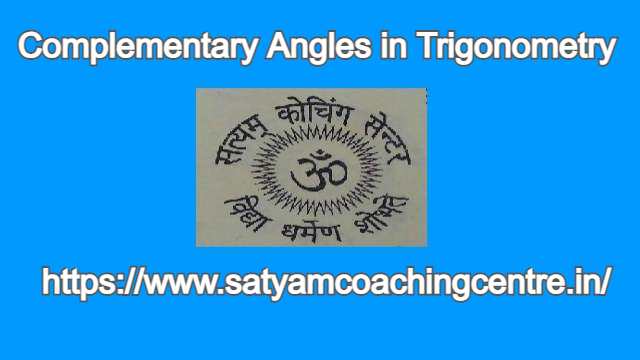Complementary Angles in Trigonometry
1.त्रिकोणमिति में पूरक कोण (Complementary Angles in Trigonometry),पूरक कोणों के त्रिकोणमितीय अनुपात (Trigonometric Ratios of Complementary Angles)-
- त्रिकोणमिति में पूरक कोण (Complementary Angles in Trigonometry) में पूरक कोण को जानना आवश्यक है।
(1.)पूरक कोण (Complementary Angles), त्रिकोणमिति में पूरक कोण क्या है? (What is complementary angle in trigonometry)-
- कोई दो कोण परस्पर पूरक कोण कहलाते हैं यदि त्रिभुज के किन्हीं दो का योग 90° हो।
- माना एक परिक्रामी रेखा अपनी प्रारम्भिक स्थिति OX से वातावर्त (धनात्मक) दिशा में परिभ्रमण करते हुए स्थिति OP पर पहुंचती हैं और \angle XOP=\theta बनाती है।बिन्दु P से OX पर लम्ब PM डालते हैं। त्रिभुज के तीनों कोणों का योग दो समकोण होता है और कोण OPM समकोण है इसलिए कोण MOP और कोण OPM का योगफल समकोण होगा।
- अतः ये कोण परस्पर पूरक कोण होंगे और \angle OPM=90-\theta
(2.)पूरक कोणों के त्रिकोणमितीय अनुपात कक्षा 10 (Trigonometric Ratios of Complementary Angles Class 10),त्रिकोणमिति में पूरक कोण (Complementary Angles of Trigonometry)-
- चित्रानुसार पूरक कोण OPM के संगत समकोण त्रिभुज OPM में भुजा OM और PM क्रमशः लम्ब और आधार होंगे और कोण के संगत भुजा OM और PM क्रमशः आधार और लम्ब होंगे।
\sin { (90-\theta ) } =\sin { OPM } =\frac { OM }{ OP } =\cos { XOP } =\cos { \theta } \\ \cos { (90-\theta ) } =\cos { OPM } =\frac { PM }{ OP } =\sin { XOP } =\sin { \theta } \\ \tan { (90-\theta ) } =\tan { OPM } =\frac { OM }{ PM } =\cot { XOP } =\cot { \theta } \\ \cot { (90-\theta ) } =\cot { OPM } =\frac { PM }{ OM } =\tan { XOP } =\tan { \theta } \\ \sec { (90-\theta ) } =\sec { OPM } =\frac { OP }{ PM } =cosecXOP=cosec\theta \\ \csc { (90-\theta ) } =cosecOPM=\frac { OP }{ OM } =\sec { XOP } =\sec { \theta }
इस प्रकार
\sin { ({ 90 }^{ \circ }-\theta ) } =\cos { \theta } [जब 0\le \theta \le { 90 }^{ \circ }]
\cos { ({ 90 }^{ \circ }-\theta ) } =\sin { \theta } [जब 0\le \theta \le { 90 }^{ \circ }]
\tan { ({ 90 }^{ \circ }-\theta ) } =\cot { \theta } [जब 0\le \theta \le { 90 }^{ \circ }]
\cot { ({ 90 }^{ \circ }-\theta ) } =\tan { \theta } [जब 0\le \theta \le { 90 }^{ \circ }]
\sec { ({ 90 }^{ \circ }-\theta ) } =cosec\theta [जब 0\le \theta \le { 90 }^{ \circ }]
\csc { ({ 90 }^{ \circ }-\theta ) } =\sec { \theta } [जब 0\le \theta \le { 90 }^{ \circ }]
यहां हम देख सकते हैं कि \sin { { 0 }^{ \circ } } =\cos { { 90 }^{ \circ } } =\tan { 0 } =\cot { { 90 }^{ \circ } } =0
परन्तु \tan { { { 90 }^{ \circ } } } ,\cot { { 0 }^{ \circ } } ,\sec { { { 90 }^{ \circ } } } ,cosec{ 0 }^{ \circ } परिभाषित नहीं है |
- टिप्पणी-हम देख सकते हैं कि
किसी कोण का sine=उसके पूरक कोण का cosine
किसी कोण कारण cosine=उसके पूरक कोण का sine
किसी कोण का tangent=उसके पूरक कोण का cotangent
किसी कोण का secant=उसके पूरक कोण का cosecant
किसी कोण का cosecant=उसके पूरक कोण का secant
यदि किसी त्रिकोणमितीय अनुपात का पूरक कोण ज्ञात करना है तो दिए गए कोण के त्रिकोणमितीय अनुपात में co न हो तो co लगा देते हैं।यदि co लगा है तो उसे हटा देते हैं। - आपको यह जानकारी रोचक व ज्ञानवर्धक लगे तो अपने मित्रों के साथ इस गणित के आर्टिकल को शेयर करें।यदि आप इस वेबसाइट पर पहली बार आए हैं तो वेबसाइट को फॉलो करें और ईमेल सब्सक्रिप्शन को भी फॉलो करें।जिससे नए आर्टिकल का नोटिफिकेशन आपको मिल सके ।यदि आर्टिकल पसन्द आए तो अपने मित्रों के साथ शेयर और लाईक करें जिससे वे भी लाभ उठाए ।आपकी कोई समस्या हो या कोई सुझाव देना चाहते हैं तो कमेंट करके बताएं। इस आर्टिकल को पूरा पढ़ें।
Also Read This Article:-Relation Between Trigonometric Ratios
2.त्रिकोणमिति में पूरक कोण के उदाहरण (Complementary Angles in Trigonometry Examples),पूरक कोणों के त्रिकोणमितीय अनुपात (Trigonometric Ratios of Complementary Angles Examples)-
निम्नलिखित के मान ज्ञात कीजिए:
Example-1.\frac { cosec{ 32 }^{ \circ } }{ \sec { { 58 }^{ \circ } } }
Solution-\frac { cosec{ 32 }^{ \circ } }{ \sec { { 58 }^{ \circ } } } \\ =\frac { cosec{ (90 }^{ \circ }-{ 58 }^{ \circ }) }{ \sec { { 58 }^{ \circ } } } \\ =\frac { \sec { { 58 }^{ \circ } } }{ \sec { { 58 }^{ \circ } } } [\because cosec{ (90 }^{ \circ }-\theta )=\sec { \theta } ]\\ =1
Example-2.\frac { \tan { { 10 }^{ \circ } } }{ \cot { { 80 }^{ \circ } } }
Solution-\frac { \tan { { 10 }^{ \circ } } }{ \cot { { 80 }^{ \circ } } } \\ =\frac { \tan { { (90 }^{ \circ }-{ 80 }^{ \circ }) } }{ \cot { { 80 }^{ \circ } } } \\ =\frac { \cot { { 80 }^{ \circ } } }{ \cot { { 80 }^{ \circ } } } [\because \tan { { (90 }^{ \circ }-\theta ) } =\cot { \theta } ]\\ =1
Example-3.\frac { \sin { { 36 }^{ \circ } } }{ \cos { { 54 }^{ \circ } } } -\frac { \sin { { 54 }^{ \circ } } }{ \cos { { 36 }^{ \circ } } }
Solution-\frac { \sin { { 36 }^{ \circ } } }{ \cos { { 54 }^{ \circ } } } -\frac { \sin { { 54 }^{ \circ } } }{ \cos { { 36 }^{ \circ } } } \\ =\frac { \sin { { { (90 }^{ \circ }-{ 54 }^{ \circ }) } } }{ \cos { { 54 }^{ \circ } } } -\frac { \sin { { { (90 }^{ \circ }-{ 36 }^{ \circ }) } } }{ \cos { { 36 }^{ \circ } } } \\ =\frac { \cos { { 54 }^{ \circ } } }{ \cos { { 54 }^{ \circ } } } -\frac { \cos { { 36 }^{ \circ } } }{ \cos { { 36 }^{ \circ } } } \\ [\because \sin { ({ 90 }^{ \circ }-\theta ) } =\cos { \theta } ,\cos { ({ 90 }^{ \circ }-\theta ) } =\sin { \theta } ]\\ =1-1\\ =0
Example-4.\sin { \theta } \cos { ({ 90 }^{ \circ }-\theta ) } +\cos { \theta } \sin { ({ 90 }^{ \circ }-\theta ) }
Solution-\sin { \theta } \cos { ({ 90 }^{ \circ }-\theta ) } +\cos { \theta } \sin { ({ 90 }^{ \circ }-\theta ) } \\ =\sin { \theta } \sin { \theta } +\cos { \theta } \cos { \theta } \\ [\because \sin { ({ 90 }^{ \circ }-\theta ) } =\cos { \theta } ,\cos { ({ 90 }^{ \circ }-\theta ) } =\sin { \theta } ]\\ =\sin ^{ 2 }{ \theta } +\cos ^{ 2 }{ \theta } \\ =1[\because \sin ^{ 2 }{ \theta } +\cos ^{ 2 }{ \theta } =1]
Example-5.\frac { 2\cos { { 67 }^{ \circ } } }{ \sin { { 23 }^{ \circ } } } -\frac { \tan { { 40 }^{ \circ } } }{ \cot { { 50 }^{ \circ } } } -\cos { { 60 }^{ \circ } }
Solution-\frac { 2\cos { { 67 }^{ \circ } } }{ \sin { { 23 }^{ \circ } } } -\frac { \tan { { 40 }^{ \circ } } }{ \cot { { 50 }^{ \circ } } } -\cos { { 60 }^{ \circ } } \\ =\frac { 2\cos { { ({ 90 }^{ \circ }-{ 23 }^{ \circ }) } } }{ \sin { { 23 }^{ \circ } } } -\frac { \tan { ({ 90 }^{ \circ }-{ 50 }^{ \circ }) } }{ \cot { { 50 }^{ \circ } } } -\cos { { 60 }^{ \circ } } \\ =\frac { 2\sin { { 23 }^{ \circ } } }{ \sin { { 23 }^{ \circ } } } -\frac { \cot { { 50 }^{ \circ } } }{ \cot { { 50 }^{ \circ } } } -\cos { { 60 }^{ \circ } } \\ [\because \tan { { (90 }^{ \circ }-\theta ) } =\cot { \theta } ,\cos { ({ 90 }^{ \circ }-\theta ) } =\sin { \theta } ]\\ =2(1)-1-\frac { 1 }{ 2 } \\ =1-\frac { 1 }{ 2 } \\ =\frac { 1 }{ 2 }
Example-6.{ (\frac { \sin { { 35 }^{ \circ } } }{ \cos { { 55 }^{ \circ } } } ) }^{ 2 }+{ (\frac { \cos { { 55 }^{ \circ } } }{ \sin { { 35 }^{ \circ } } } ) }^{ 2 }-2\cos { { 60 }^{ \circ } }
Solution-{ (\frac { \sin { { 35 }^{ \circ } } }{ \cos { { 55 }^{ \circ } } } ) }^{ 2 }+{ (\frac { \cos { { 55 }^{ \circ } } }{ \sin { { 35 }^{ \circ } } } ) }^{ 2 }-2\cos { { 60 }^{ \circ } } \\ ={ [\frac { \sin { { (90 }^{ \circ }-{ 55 }^{ \circ }) } }{ \cos { { 55 }^{ \circ } } } ] }^{ 2 }+{ [\frac { \cos { { (90 }^{ \circ }-{ 35 }^{ \circ }) } }{ \sin { { 35 }^{ \circ } } } ] }^{ 2 }-2\cos { { 60 }^{ \circ } } \\ [\because \sin { ({ 90 }^{ \circ }-\theta ) } =\cos { \theta } ,\cos { ({ 90 }^{ \circ }-\theta ) } =\sin { \theta } ] \\ ={ [\frac { \cos { { 55 }^{ \circ } } }{ \cos { { 55 }^{ \circ } } } ] }^{ 2 }+{ [\frac { \sin { { 35 }^{ \circ } } }{ \sin { { 35 }^{ \circ } } } ] }^{ 2 }-2\cos { { 60 }^{ \circ } } \\ ={ (1) }^{ 2 }+{ (1) }^{ 2 }-2(\frac { 1 }{ 2 } )\\ =1+1-1\\ =1
Example-7.\cot { { 12 }^{ \circ } } \cot { { 38 }^{ \circ } } \cot { { 52 }^{ \circ } } \cot { { 60 }^{ \circ } } \cot { { 78 }^{ \circ } }
Solution-\cot { { 12 }^{ \circ } } \cot { { 38 }^{ \circ } } \cot { { 52 }^{ \circ } } \cot { { 60 }^{ \circ } } \cot { { 78 }^{ \circ } } \\ =\cot { ({ 90 }^{ \circ }-{ 78 }^{ \circ }) } \cot { { ({ 90 }^{ \circ }-{ 52 }^{ \circ }) } } \cot { { 52 }^{ \circ } } \cot { { 60 }^{ \circ } } \cot { { 78 }^{ \circ } } \\ =(\tan { { 78 }^{ \circ } } \cot { { 78 }^{ \circ } } )(\tan { { 52 }^{ \circ } } \cot { { 52 }^{ \circ } } )\cot { { 60 }^{ \circ } } \\ [\because \cot { ({ 90 }^{ \circ }-\theta ) } =\tan { \theta } ]\\ =(1)(1)\frac { 1 }{ \sqrt { 3 } } [\because \tan { \theta } \cot { \theta } =1]\\ =\frac { 1 }{ \sqrt { 3 } }
निम्न को 0° से 45° के कोणों के त्रिकोणमितीय अनुपात के पदों में व्यक्त कीजिए-
Example-8.\sin { { 81 }^{ \circ } } +\sin { { 71 }^{ \circ } }
Solution-\sin { { 81 }^{ \circ } } +\sin { { 71 }^{ \circ } } \\ =\sin { ({ 90 }^{ \circ }-{ 9 }^{ \circ }) } +\sin { ({ 90 }^{ \circ }-{ 19 }^{ \circ }) } \\ =\cos { { 9 }^{ \circ } } +\cos { { 19 }^{ \circ } } [\because \sin { ({ 90 }^{ \circ }-\theta ) } =\cos { \theta } ]
Example-9.\tan { { 68 }^{ \circ } } +\sec { { 68 }^{ \circ } }
Solution-\tan { { 68 }^{ \circ } } +\sec { { 68 }^{ \circ } } \\ =\tan { ({ 90 }^{ \circ }-{ 22 }^{ \circ }) } +\sec { ({ 90 }^{ \circ }-{ 22 }^{ \circ }) } \\ [\because \tan { ({ 90 }^{ \circ }-\theta ) } =\cot { \theta } ,\sec { ({ 90 }^{ \circ }-\theta ) } =cosec\theta ]\\ =\cot { { 22 }^{ \circ } } +cosec{ 22 }^{ \circ }
निम्नलिखित को सिद्ध कीजिए:
Example-10.\sin { { 65 }^{ \circ } } +\cos { { 25 }^{ \circ } } =2\cos { { 25 }^{ \circ } }
Solution-\sin { { 65 }^{ \circ } } +\cos { { 25 }^{ \circ } } =2\cos { { 25 }^{ \circ } } \\ \sin { { 65 }^{ \circ } } +\cos { { 25 }^{ \circ } } \\ =\sin { ({ 90 }^{ \circ }-{ 25 }^{ \circ }) } +\cos { { 25 }^{ \circ } } \\ =\cos { { 25 }^{ \circ } } +\cos { { 25 }^{ \circ } } [\because \sin { ({ 90 }^{ \circ }-\theta ) } =\cos { \theta } ]\\ =2\cos { { 25 }^{ \circ } } =R.H.S
Example-11.\frac { \cos { { 70 }^{ \circ } } }{ \sin { { 20 }^{ \circ } } } +\frac { \cos { { 59 }^{ \circ } } }{ \sin { { 31 }^{ \circ } } } -8\sin ^{ 2 }{ { 30 }^{ \circ } } =0
Solution-\frac { \cos { { 70 }^{ \circ } } }{ \sin { { 20 }^{ \circ } } } +\frac { \cos { { 59 }^{ \circ } } }{ \sin { { 31 }^{ \circ } } } -8\sin ^{ 2 }{ { 30 }^{ \circ } } =0\\ L.H.S=\frac { \cos { ({ 90 }^{ \circ }-{ 20 }^{ \circ }) } }{ \sin { { 20 }^{ \circ } } } +\frac { \cos { ({ 90 }^{ \circ }-{ 31 }^{ \circ }) } }{ \sin { { 31 }^{ \circ } } } -8\sin ^{ 2 }{ { 30 }^{ \circ } } \\ =\frac { \sin { { 20 }^{ \circ } } }{ \sin { { 20 }^{ \circ } } } +\frac { \sin { { 31 }^{ \circ } } }{ \sin { { 31 }^{ \circ } } } -8{ (\frac { 1 }{ 2 } ) }^{ 2 }[\because \cos { ({ 90 }^{ \circ }-\theta ) } =\sin { \theta } ]\\ =(1)+(1)-8\times \frac { 1 }{ 4 } \\ =2-2\\ =0=R.H.S
Example-12. \sin { ({ 90 }^{ \circ }-\theta ) } \cos { ({ 90 }^{ \circ }-\theta ) } =\frac { \tan { \theta } }{ 1+\tan ^{ 2 }{ \theta } }
Solution-\sin { ({ 90 }^{ \circ }-\theta ) } \cos { ({ 90 }^{ \circ }-\theta ) } =\frac { \tan { \theta } }{ 1+\tan ^{ 2 }{ \theta } } \\ L.H.S=\sin { ({ 90 }^{ \circ }-\theta ) } \cos { ({ 90 }^{ \circ }-\theta ) } \\ =\cos { \theta } \sin { \theta } [\because \sin { ({ 90 }^{ \circ }-\theta ) } =\cos { \theta } ,\cos { ({ 90 }^{ \circ }-\theta ) } =\sin { \theta } ]\\ =\frac { \cos { \theta } \sin { \theta } }{ 1 }
अंश व हर में \cos ^{ 2 }{ \theta } भाग देने पर-
=\frac { \frac { \cos { \theta } \sin { \theta } }{ \cos ^{ 2 }{ \theta } } }{ \frac { 1 }{ \cos ^{ 2 }{ \theta } } } \\ =\frac { \frac { \sin { \theta } }{ \cos { \theta } } }{ \frac { \sin ^{ 2 }{ \theta } +\cos ^{ 2 }{ \theta } }{ \cos ^{ 2 }{ \theta } } } [\because \sin ^{ 2 }{ \theta } +\cos ^{ 2 }{ \theta } =1]\\ =\frac { \tan { \theta } }{ \frac { \sin ^{ 2 }{ \theta } }{ \cos ^{ 2 }{ \theta } } +\frac { \cos ^{ 2 }{ \theta } }{ \cos ^{ 2 }{ \theta } } } \\ =\frac { \tan { \theta } }{ \tan ^{ 2 }{ \theta } +1 } \\ =\frac { \tan { \theta } }{ 1+\tan ^{ 2 }{ \theta } } =R.H.S
Example-13.\frac { \sin { ({ 90 }^{ \circ }-\theta ) } \cos { ({ 90 }^{ \circ }-\theta ) } }{ \tan { ({ 90 }^{ \circ }-\theta ) } } =\sin ^{ 2 }{ \theta }
Solution-\frac { \sin { ({ 90 }^{ \circ }-\theta ) } \cos { ({ 90 }^{ \circ }-\theta ) } }{ \tan { ({ 90 }^{ \circ }-\theta ) } } =\sin ^{ 2 }{ \theta } \\ L.H.S=\frac { \sin { ({ 90 }^{ \circ }-\theta ) } \cos { ({ 90 }^{ \circ }-\theta ) } }{ \tan { ({ 90 }^{ \circ }-\theta ) } } \\ =\frac { \cos { \theta } \sin { \theta } }{ \cot { \theta } } \\ [\because \sin { ({ 90 }^{ \circ }-\theta ) } =\cos { \theta } ,\cos { ({ 90 }^{ \circ }-\theta ) } =\sin { \theta } , \tan { ({ 90 }^{ \circ }-\theta ) } =\cot { \theta } ]\\ =\frac { \cos { \theta } \sin { \theta } }{ \frac { \cos { \theta } }{ \sin { \theta } } } [\because \cot { \theta } =\frac { \cos { \theta } }{ \sin { \theta } } ]\\ =\frac { \cos { \theta } \sin { \theta } }{ 1 } \times \frac { \sin { \theta } }{ \cos { \theta } } \\ =\sin ^{ 2 }{ \theta } =R.H.S
Example-14.\frac { \sin { \theta } \cos { ({ 90 }^{ \circ }-\theta ) } \cos { \theta } }{ \sec { ({ 90 }^{ \circ }-\theta ) } } +\frac { \cos { \theta } \sin { ({ 90 }^{ \circ }-\theta ) } \sin { \theta } }{ cosec({ 90 }^{ \circ }-\theta ) } =\sin { \theta } \cos { \theta }
Solution-\frac { \sin { \theta } \cos { ({ 90 }^{ \circ }-\theta ) } \cos { \theta } }{ \sec { ({ 90 }^{ \circ }-\theta ) } } +\frac { \cos { \theta } \sin { ({ 90 }^{ \circ }-\theta ) } \sin { \theta } }{ cosec({ 90 }^{ \circ }-\theta ) } =\sin { \theta } \cos { \theta } \\ L.H.S=\frac { \sin { \theta } \cos { ({ 90 }^{ \circ }-\theta ) } \cos { \theta } }{ \sec { ({ 90 }^{ \circ }-\theta ) } } +\frac { \cos { \theta } \sin { ({ 90 }^{ \circ }-\theta ) } \sin { \theta } }{ cosec({ 90 }^{ \circ }-\theta ) } \\ =\frac { \sin { \theta } \sin { \theta } \cos { \theta } }{ cosec\theta } +\frac { \cos { \theta } \cos { \theta } \sin { \theta } }{ \sec { \theta } } \\ [\because \sin { ({ 90 }^{ \circ }-\theta ) } =\cos { \theta } ,\cos { ({ 90 }^{ \circ }-\theta ) } =\sin { \theta } , \sec { ({ 90 }^{ \circ }-\theta ) } =cosec\theta ,\sec { ({ 90 }^{ \circ }-\theta ) } =\sec { \theta } ]\\ =\frac { \sin ^{ 2 }{ \theta } \cos { \theta } }{ \frac { 1 }{ \sin { \theta } } } +\frac { \cos ^{ 2 }{ \theta } \sin { \theta } }{ \frac { 1 }{ \cos { \theta } } } [\because cosec\theta =\frac { 1 }{ \sin { \theta } } ,\sec { \theta } =\frac { 1 }{ \cos { \theta } } ]\\ =\sin ^{ 3 }{ \theta } \cos { \theta } +\cos ^{ 3 }{ \theta } \sin { \theta } \\ =\sin { \theta } \cos { \theta } (\sin ^{ 2 }{ \theta } +\cos ^{ 2 }{ \theta } )\\ =\sin { \theta } \cos { \theta } [\because \sin ^{ 2 }{ \theta } +\cos ^{ 2 }{ \theta } =1]\\ =R.H.S
Example-15. यदि \sin { 3\theta } =\cos { (\theta -6°) } यहां 3\theta और (\theta -6°) न्यून कोण है तो का मान ज्ञात कीजिए।
Solution-\sin { 3\theta } =\cos { (\theta -6°) } \\ \Rightarrow \cos { ({ 90 }^{ \circ }-3\theta ) } =\cos { (\theta -6°) } [\because \cos { ({ 90 }^{ \circ }-\theta ) } =\sin { \theta } ]\\ \Rightarrow { 90 }^{ \circ }-3\theta =\theta -6°\\ \Rightarrow -3\theta -\theta =-6°-90°\\ \Rightarrow -4\theta =-96°\\ \Rightarrow \theta =\frac { 96° }{ 4 } \\ \Rightarrow \theta =24°
Example-16. यदि \sec { 5\theta } =cosec(\theta -{ 36 }^{ \circ }) यहां 5\theta एक न्यून कोण है तो का मान ज्ञात कीजिए।
Solution-\sec { 5\theta } =cosec(\theta -{ 36 }^{ \circ })\\ \Rightarrow cosec({ 90 }^{ \circ }-5\theta )=cosec(\theta -{ 36 }^{ \circ })[\because cosec({ 90 }^{ \circ }-\theta )=\sec { \theta } ]\\ \Rightarrow { 90 }^{ \circ }-5\theta =\theta -{ 36 }^{ \circ }\\ \Rightarrow -5\theta -\theta =-{ 36 }^{ \circ }-{ 90 }^{ \circ }\\ \Rightarrow -6\theta =-{ 126 }^{ \circ }\\ \Rightarrow \theta =\frac { { 126 }^{ \circ } }{ 6 } \\ \Rightarrow \theta ={ 21 }^{ \circ }
Example-17.यदि A,B और C किसी त्रिभुज के अन्त:कोण हो तो सिद्ध कीजिए कि \tan { (\frac { B+C }{ 2 } ) } =\cot { \frac { A }{ 2 } }
Solution- \triangle ABC में
A+B+C={ 180 }^{ \circ }\\ \Rightarrow B+C={ 180 }^{ \circ }-A\\ \Rightarrow \frac { B+C }{ 2 } =\frac { { 180 }^{ \circ }-A }{ 2 } \\ \Rightarrow \frac { B+C }{ 2 } ={ 90 }^{ \circ }-\frac { A }{ 2 } \\ \Rightarrow \tan { (\frac { B+C }{ 2 } ) } =\tan { ({ 90 }^{ \circ }-\frac { A }{ 2 } ) } \\ \Rightarrow \tan { (\frac { B+C }{ 2 } ) } =\cot { \frac { A }{ 2 } } [\because \tan { ({ 90 }^{ \circ }-\theta ) } =\cot { \theta } ]
Example-18.निम्नलिखित समीकरण से x का मान ज्ञात कीजिए:
\sec { ({ 90 }^{ \circ }-\theta ) } +x\sin { \theta } \tan { ({ 90 }^{ \circ }-\theta ) } =\cos { ({ 90 }^{ \circ }-\theta ) }
Solution-\sec { ({ 90 }^{ \circ }-\theta ) } +x\sin { \theta } \tan { ({ 90 }^{ \circ }-\theta ) } =\cos { ({ 90 }^{ \circ }-\theta ) } \\ \Rightarrow cosec\theta +x\sin { \theta } \cot { \theta } =\sin { \theta } [\because \sec { ({ 90 }^{ \circ }-\theta ) } =cosec\theta ,\tan { ({ 90 }^{ \circ }-\theta ) } =\cot { \theta } ,\cos { ({ 90 }^{ \circ }-\theta ) } =\sin { \theta } ]\\ \Rightarrow \frac { 1 }{ \sin { \theta } } +x\sin { \theta } (\frac { \cos { \theta } }{ \sin { \theta } } )=\sin { \theta } [\because cosec\theta =\frac { 1 }{ \sin { \theta } } ,\cot { \theta } =\frac { \cos { \theta } }{ \sin { \theta } } ]\\ \Rightarrow x\cos { \theta } =\sin { \theta } -\frac { 1 }{ \sin { \theta } } \\ \Rightarrow x\cos { \theta } =\frac { \sin ^{ 2 }{ \theta } -1 }{ \sin { \theta } } \\ \Rightarrow x\cos { \theta } =-\frac { (1-\sin ^{ 2 }{ \theta } ) }{ \sin { \theta } } \\ \Rightarrow x=-\frac { \cos ^{ 2 }{ \theta } }{ \sin { \theta \cos { \theta } } } [\because 1-\sin ^{ 2 }{ \theta } =\cos ^{ 2 }{ \theta } ]\\ \Rightarrow x=-\frac { \cos { \theta } }{ \sin { \theta } } \\ \Rightarrow x=-\cot { \theta }
Example-19.निम्नलिखित समीकरण से x का मान ज्ञात कीजिए।
cosec({ 90 }^{ \circ }-\theta )+x\cos { \theta } \cot { ({ 90 }^{ \circ }-\theta ) } =\sin { ({ 90 }^{ \circ }-\theta ) }
Solution-cosec({ 90 }^{ \circ }-\theta )+x\cos { \theta } \cot { ({ 90 }^{ \circ }-\theta ) } =\sin { ({ 90 }^{ \circ }-\theta ) } \\ \sec { \theta } +x\cos { \theta } \tan { \theta } =\cos { \theta } \\ [\because cosec({ 90 }^{ \circ }-\theta )=\sec { \theta } ,\cot { ({ 90 }^{ \circ }-\theta ) } =\tan { \theta } ,\sin { ({ 90 }^{ \circ }-\theta ) } =\cos { \theta } ]\\ \Rightarrow \frac { 1 }{ \cos { \theta } } +x\sin { \theta } =\cos { \theta } \\ \Rightarrow x\sin { \theta } =\cos { \theta } -\frac { 1 }{ \cos { \theta } } \\ \Rightarrow x\sin { \theta } =\frac { \cos ^{ 2 }{ \theta } -1 }{ \cos { \theta } } \\ \Rightarrow x\sin { \theta } =-\frac { (1-\cos ^{ 2 }{ \theta } ) }{ \cos { \theta } } \\ \Rightarrow x\sin { \theta } =-\frac { \sin ^{ 2 }{ \theta } }{ \cos { \theta } } [\because 1-\cos ^{ 2 }{ \theta } =\sin ^{ 2 }{ \theta } ]\\ \Rightarrow x=-\frac { \sin ^{ 2 }{ \theta } }{ \sin { \theta } \cos { \theta } } \\ \Rightarrow x=-\frac { \sin { \theta } }{ \cos { \theta } } \\ \Rightarrow x=-\tan { \theta } [\because \frac { \sin { \theta } }{ \cos { \theta } } =\tan { \theta } ]
Example-20.यदि \sin { { 34 }^{ \circ } } =p हो तो \cot { { 56 }^{ \circ } } का मान ज्ञात कीजिए।
Solution:-p=\sin { { 34 }^{ \circ } } \\ \Rightarrow p=\sin { ({ 90 }^{ \circ }-{ 56 }^{ \circ }) } \\ \Rightarrow p=\cos { { 56 }^{ \circ } } \\ \Rightarrow { p }^{ 2 }=\cos ^{ 2 }{ { 56 }^{ \circ } } \\ \Rightarrow { p }^{ 2 }=1-\sin ^{ 2 }{ { 56 }^{ \circ } } [\because \cos ^{ 2 }{ \theta } =1-\sin ^{ 2 }{ \theta } ]\\ \Rightarrow \sin ^{ 2 }{ { 56 }^{ \circ } } =1-{ p }^{ 2 }\\ \Rightarrow \sin { { 56 }^{ \circ } } =\sqrt { 1-{ p }^{ 2 } } \\ \Rightarrow cosec{ 56 }^{ \circ }=\frac { 1 }{ \sqrt { 1-{ p }^{ 2 } } } \\ \Rightarrow { cosec }^{ 2 }{ 56 }^{ \circ }=\frac { 1 }{ 1-{ p }^{ 2 } } \\ \Rightarrow 1+\cot ^{ 2 }{ { 56 }^{ \circ } } =\frac { 1 }{ 1-{ p }^{ 2 } } \\ \Rightarrow \cot ^{ 2 }{ { 56 }^{ \circ } } =-1+\frac { 1 }{ 1-{ p }^{ 2 } } \\ \Rightarrow \cot ^{ 2 }{ { 56 }^{ \circ } } =\frac { { p }^{ 2 } }{ 1-{ p }^{ 2 } } \\ \Rightarrow \cot { { 56 }^{ \circ } } =\frac { p }{ \sqrt { 1-{ p }^{ 2 } } }
- उपर्युक्त उदाहरणों के द्वारा त्रिकोणमिति में पूरक कोण (Complementary Angles in Trigonometry),पूरक कोणों के त्रिकोणमितीय अनुपात (Trigonometric Ratios of Complementary Angles) को समझ सकते हैं।
3.त्रिकोणमिति में पूरक कोण के सवाल (Complementary Angles in Trigonometry Questions),पूरक कोणों के त्रिकोणमितीय अनुपात के सवाल (Trigonometric Ratios of Complementary Angles Questions)-
निम्नलिखित के मान ज्ञात कीजिए:
(1)\frac { \cos { 37° } }{ \sin { 53° } } \\ (2)\frac { \cos { 19° } }{ \sin { 71° } } \\ (3)cosec25°-\sec { 65° } \\ (4)\cot { 34° } -\tan { 56° } \\ (5)\sin { 70° } \sin { 20° } -\cos { 20° } \cos { 70° } \\ (6)\tan { 5° } \tan { 25° } \tan { 30° } \tan { 65° } \tan { 85° } \\ (7)\sin ^{ 2 }{ 50° } +\sin ^{ 2 }{ 40° } \\ (8)\sec { 50° } \sin { 40° } +\cos { 40° } cosec50°\\ (9)\tan { 39° } -\cot { 51° } \\ (10)\sin ^{ 2 }{ 53° } +\sin ^{ 2 }{ 37° } -2\cos { 60° } +\tan { 45° }
निम्नलिखित को सिद्ध कीजिए:
(11)\sin { 35° } \sin { 55° } -\cos { 35° } \cos { 55° } =0\\ (12)\frac { \cos { (90°-\theta ) } \cos { \theta } }{ \tan { \theta } } +\cos ^{ 2 }{ (90°-\theta ) } =1\\ (13)\frac { \tan { (90°-\theta ) } \cot { \theta } }{ { cosec }^{ 2 }\theta } -\cos ^{ 2 }{ \theta } =0\\ (14)\frac { \sin { \theta } \cos { (90°-\theta ) } \cos { \theta } }{ \sec { (90°-\theta ) } } +\frac { \cos { \theta } \sin { (90°-\theta ) } \sin { \theta } }{ cosec(90°-\theta ) } =\sin { \theta } \cos { \theta } \\ (15)\tan { 15° } \tan { 20° } \tan { 70° } \tan { 75° } =1\\ (16)\cos { 38° } \cos { 52° } -\sin { 38° } \sin { 52° } =0
(17.)यदि \tan { 2A } =\cot { (A- } 18°) जहां 2A न्यून कोण है तो A का मान ज्ञात कीजिए।
(18.)यदि \tan { A } =\cot { B } तो सिद्ध कीजिए A+B=90°
(19.)यदि A,B व C त्रिभुज ABC के अन्त:कोण हों तो सिद्ध कीजिए कि:
(i)\sin { (\frac { A+B }{ 2 } ) } =\cos { \frac { C }{ 2 } } (ii)\tan { (\frac { B+C }{ 2 } ) } =\cot { \frac { A }{ 2 } }
(20.) यदि \theta =60° हो तो सिद्ध कीजिए:
[\frac { cosec(90°-\theta )+1 }{ \cot { (90°-\theta ) } } ]=\frac { cosec(90°-\theta )+1 }{ \sec { \theta -1 } }
उत्तर (Answer)-
(1.) 1
(2.) 1
(3.) 0
(4.) 0
(5.) 0
(6.)\frac { 1 }{ \sqrt { 3 } }
(7.) 1
(8.) 2
(9.) 0
(10.) 1
(17.) A=36°
- इन सवालों को हल करने पर त्रिकोणमिति में पूरक कोण (Complementary Angles in Trigonometry),पूरक कोणों के त्रिकोणमितीय अनुपात (Trigonometric Ratios of Complementary Angles) को ओर ठीक से समझा जा सकता है।
4.पूरक कोणों के त्रिकोणमितीय अनुपात क्या है? (What is Trigonometric Ratios of Complementary Angles?), त्रिकोणमिति में पूरक कोण क्या हैं? (What are complementary angles in trigonometry)-
- गणित में,पूरक कोण दो कोणों का समुच्चय हैं,जैसे कि उनका योग 90° के बराबर है।उदाहरण के लिए, 30° और 60° एक दूसरे के पूरक हैं क्योंकि उनका योग 90° के बराबर है।
5.आप त्रिकोणमिति में पूरक कोणों को कैसे हल करते हैं? (How do you solve complementary angles in trigonometry?)-
- ''दो कोण जिनका योग 90∘ है उन्हें पूरक कोण कहा जाता है। ''
इस त्रिकोण में, α और β पूरक कोण हैं क्योंकि:
α + β + 90∘ = 180∘ (त्रिभुज के तीनों कोणों का योग 180∘ है)
=> α + β = 90∘
=> α और β पूरक कोण हैं। - पूरक कोणों के त्रिकोणमितीय अनुपात θ और (90-θ) हैं।
Also Read This Article:-Trigonometric Identities Class 10
| No. | Social Media | Url |
|---|---|---|
| 1. | click here | |
| 2. | you tube | click here |
| 3. | click here | |
| 4. | click here | |
| 5. | Facebook Page | click here |









